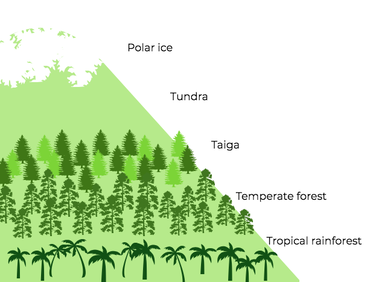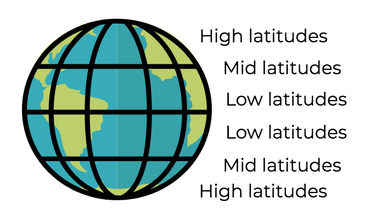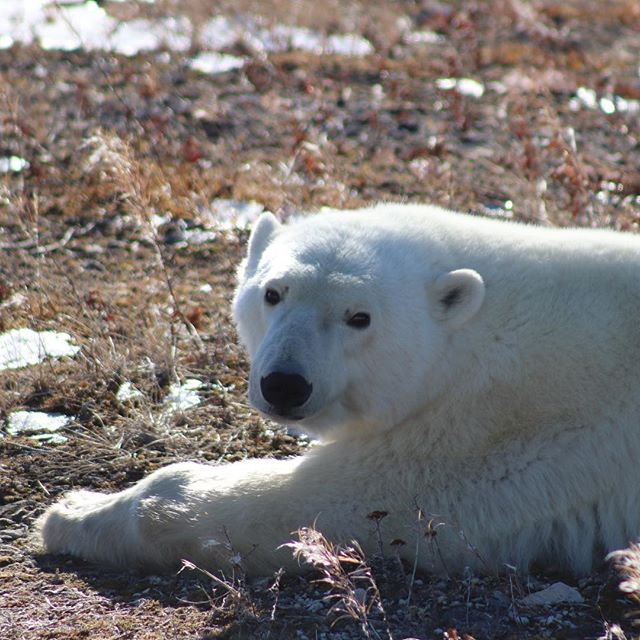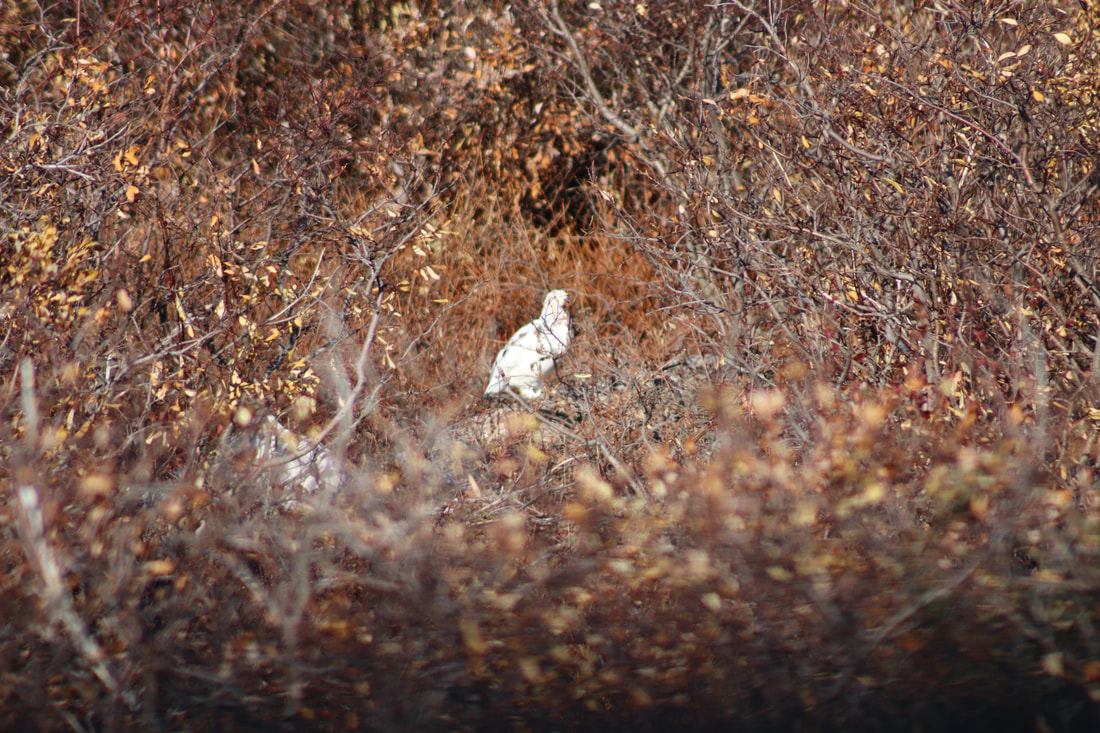Tundra - Biophysical Interactions
Pre-lesson activity
Refer to an atlas, and examine world maps showing patterns of:
- World Biomes
- Climatic zones
- Soil types
Tundra characteristics
Tundra facts and information
The tundra biome
Refer to an atlas, and examine world maps showing patterns of:
- World Biomes
- Climatic zones
- Soil types
- Describe the location of tundra environments globally?
- What climatic zones correlate with the location of tundra environments?
- What soil types correspond with the location of tundra environments?
- Describe the location of tundra environments in relation to latitude.
Tundra characteristics
Tundra facts and information
The tundra biome
|
Latitude and Altitude
Tundra occurs only in perennially cold climates of high latitude and high altitudes. High latitude refers to locations furthest away from the Equator, and closest to the poles. It usually refers to locations about 60 degrees latitude. The extreme cold temperatures and permafrost inhibit tree growth. The arctic and antarctic tree line can very based on a range of climate and topographic features so 60 degrees latitude is indicative only. Altitude (height above sea level) also impacts on types of vegetation that can survive. The alpine tree line marks the location above which trees can no longer survive. This is due to a number of factors such a tree sap freezing, excessive snow, decreasing air temperature, and shortened growing periods. |
Atmospheric processes
Climate
The Tundra Climate zone refers to the climate of high-latitude region between 60-75 degrees latitude. Using the Koppen Scheme it is known as ET. E refers to locations with no month with average temperatures above 10 degrees celsius. T refers to locations with at least 1 month with average temperatures between 0-10 degrees celsius. Characteristics include long, cold, dark winters, and brief, cool summers.
Temperature
In Tundra climates there are only 1-4 months when average temperatures are above freezing. The average winter temperature is -34 degrees celsius, and the average summer temperature is 3-12 degrees celsius. Annual temperature ranges are fairly large, and mean annual temperatures are sub-freezing. Daily temperature ranges are small because nocturnal cooling is limited in summer due to the sun being above the horizon for most of the time. In winter, daytime warming is almost nonexistent.
Precipitation
Precipitation is very sparse and there is a moderately low annual precipitation (less than 25cm annually). More rain falls in the warm season than in winter and most precipitation that is received is in the form of snow. Winter snow is dry and granular and there is little/no melting of snow.
Humidity
Moisture availability is restricted. Air is too cold to hold much water. Humidity is always very low.
Radiation fog
Radiation fog is common. It is a type of fog that forms overnight as the air near the ground cools, stabilises and reaches saturation point. Radiation fog will begin to form near the surface and then thickens as the air continues to cool.
Read more about the tundra climate
Click to examine the Climate Atlas of Canada.
Hydrospheric processes
Transpiration
There is limited transpiration due to the limited amount of vegetation.
Evaporation
Surface and soil water is frozen for most of the year so there is little evaporation and low stores of water in the atmosphere.
Precipitation
There is a low annual precipitation - mainly in the form of snow.
Groundwater
In summer, meltwater forms many wetland areas, ponds and lakes. The water in the uppermost layer of permafrost melts in spring and summer.
Infiltration
Permafrost is a barrier to infiltration and percolation.
Water storage
Accumulation of snow and river and lake ice during winter.
River flow increases when snow, ricer and lake ice melts.
Lithospheric processes
Bedrock and soils impact on the stability of the ground to build on, and the types of vegetation and fauna present. Permafrost is any ground (soils, rocks, etc) that remains frozen for at least two years straight. Permafrost is common in high latitudes and high altitudes. For more information visit What is permafrost?
The permafrost and crystalinne rocks mean that tundra soils tend to be quite impermeable. This means that they don't allow water to infiltrate, or drain away. As a result during summer months when snow and ice has melted, lakes, and wetlands form, and soils are waterlogged.
During the growing seasons (spring and summer), plants put carbon-rich litter into the soil. This will be made up of dead leaves, sticks, etc. Animal droppings will also contribute to the soils. The litter will decompose, but because of the low temperatures the decomposition will be much slower than in many other ecosystems. Permafrost is a vast store of carbon.
Snow covers large sections of the ground for much of the year. The cold temperatures make it difficult for microbiotic organisms to breakdown organic material. However, it is thought that snow cover may actually provide insulation in some areas for microbiotic organisms to allow some decomposition despite the low temperatures.
Erosion is the wearing away of materials (soils, rocks, etc) by natural forces such as wind and water. Weathering is when materials (soils, rocks, etc) or broken down or dissolved by environmental factors. There are three types of weathering: physical, chemical and biological. Arctic tundra is particularly affected by strong winds and the erosion caused by it. The removal of this fragile soil is influenced by the limited vegetation in tundra environments. The long term effect of erosion and weathering on arctic tundra has resulted in predominantly low, flat relief. Most tundra environments have not been as affected by weathering as many other environments. Around 9,000-11,000 years ago most tundra environments will still covered by glaciers.
For more details read Wind Erosion and Arctic Tundra: Carbon Effects.
Glaciation has shaped the landscape. Processes of abrasion, plucking and freeze-thaw weathering have created the landforms in many arctic tundra environments. Abrasion is when rocks that have been frozen into the base and side of a glacier scrape along bedrock as the glacier moves downslope. This leaves scratched in the bedrock called striations. Plucking occurs when rocks become frozen into the glacier and as the glacier moves it picks up the rocks and moves them to another location. These rocks are then deposited randomly. Freeze-thaw weathering occurs when ice melts, fills cracks in the rocks and then expands when it refreezes. To learn more about glacial landforms explore Bitesize: Glacial processes and landforms.
Climate
The Tundra Climate zone refers to the climate of high-latitude region between 60-75 degrees latitude. Using the Koppen Scheme it is known as ET. E refers to locations with no month with average temperatures above 10 degrees celsius. T refers to locations with at least 1 month with average temperatures between 0-10 degrees celsius. Characteristics include long, cold, dark winters, and brief, cool summers.
Temperature
In Tundra climates there are only 1-4 months when average temperatures are above freezing. The average winter temperature is -34 degrees celsius, and the average summer temperature is 3-12 degrees celsius. Annual temperature ranges are fairly large, and mean annual temperatures are sub-freezing. Daily temperature ranges are small because nocturnal cooling is limited in summer due to the sun being above the horizon for most of the time. In winter, daytime warming is almost nonexistent.
Precipitation
Precipitation is very sparse and there is a moderately low annual precipitation (less than 25cm annually). More rain falls in the warm season than in winter and most precipitation that is received is in the form of snow. Winter snow is dry and granular and there is little/no melting of snow.
Humidity
Moisture availability is restricted. Air is too cold to hold much water. Humidity is always very low.
Radiation fog
Radiation fog is common. It is a type of fog that forms overnight as the air near the ground cools, stabilises and reaches saturation point. Radiation fog will begin to form near the surface and then thickens as the air continues to cool.
Read more about the tundra climate
Click to examine the Climate Atlas of Canada.
Hydrospheric processes
Transpiration
There is limited transpiration due to the limited amount of vegetation.
Evaporation
Surface and soil water is frozen for most of the year so there is little evaporation and low stores of water in the atmosphere.
Precipitation
There is a low annual precipitation - mainly in the form of snow.
Groundwater
In summer, meltwater forms many wetland areas, ponds and lakes. The water in the uppermost layer of permafrost melts in spring and summer.
Infiltration
Permafrost is a barrier to infiltration and percolation.
Water storage
Accumulation of snow and river and lake ice during winter.
River flow increases when snow, ricer and lake ice melts.
Lithospheric processes
Bedrock and soils impact on the stability of the ground to build on, and the types of vegetation and fauna present. Permafrost is any ground (soils, rocks, etc) that remains frozen for at least two years straight. Permafrost is common in high latitudes and high altitudes. For more information visit What is permafrost?
The permafrost and crystalinne rocks mean that tundra soils tend to be quite impermeable. This means that they don't allow water to infiltrate, or drain away. As a result during summer months when snow and ice has melted, lakes, and wetlands form, and soils are waterlogged.
During the growing seasons (spring and summer), plants put carbon-rich litter into the soil. This will be made up of dead leaves, sticks, etc. Animal droppings will also contribute to the soils. The litter will decompose, but because of the low temperatures the decomposition will be much slower than in many other ecosystems. Permafrost is a vast store of carbon.
Snow covers large sections of the ground for much of the year. The cold temperatures make it difficult for microbiotic organisms to breakdown organic material. However, it is thought that snow cover may actually provide insulation in some areas for microbiotic organisms to allow some decomposition despite the low temperatures.
Erosion is the wearing away of materials (soils, rocks, etc) by natural forces such as wind and water. Weathering is when materials (soils, rocks, etc) or broken down or dissolved by environmental factors. There are three types of weathering: physical, chemical and biological. Arctic tundra is particularly affected by strong winds and the erosion caused by it. The removal of this fragile soil is influenced by the limited vegetation in tundra environments. The long term effect of erosion and weathering on arctic tundra has resulted in predominantly low, flat relief. Most tundra environments have not been as affected by weathering as many other environments. Around 9,000-11,000 years ago most tundra environments will still covered by glaciers.
For more details read Wind Erosion and Arctic Tundra: Carbon Effects.
Glaciation has shaped the landscape. Processes of abrasion, plucking and freeze-thaw weathering have created the landforms in many arctic tundra environments. Abrasion is when rocks that have been frozen into the base and side of a glacier scrape along bedrock as the glacier moves downslope. This leaves scratched in the bedrock called striations. Plucking occurs when rocks become frozen into the glacier and as the glacier moves it picks up the rocks and moves them to another location. These rocks are then deposited randomly. Freeze-thaw weathering occurs when ice melts, fills cracks in the rocks and then expands when it refreezes. To learn more about glacial landforms explore Bitesize: Glacial processes and landforms.
Biospheric processes
Plants
Plants in tundra environments occur in ground-hugging, dense clumps. In some areas there is considerable bare ground. Tundra plants are a mix of low plants including dwarf shrubs, mosses, lichens, grasses, and forbs. No trees occur in tundra environments because the summer is so short that the conditions don't allow their growth. During the brief summer season, plants quickly complete their annual cycles. This is enabled by the moisture in the soil during this time.
Animals
Birds and insects (including mosquitoes and flies) dominate animal life in the tundra during summer. Insects eggs are able to survive the winter. Tundra becomes a an important site for nesting in summer, for birds migrating south in winter. While there are very few species of reptiles and amphibians, there are some species of mammals and freshwater fish.
Food chains and food webs
Read About Food Chains in the Tundra Ecosystem.
Plants
Plants in tundra environments occur in ground-hugging, dense clumps. In some areas there is considerable bare ground. Tundra plants are a mix of low plants including dwarf shrubs, mosses, lichens, grasses, and forbs. No trees occur in tundra environments because the summer is so short that the conditions don't allow their growth. During the brief summer season, plants quickly complete their annual cycles. This is enabled by the moisture in the soil during this time.
Animals
Birds and insects (including mosquitoes and flies) dominate animal life in the tundra during summer. Insects eggs are able to survive the winter. Tundra becomes a an important site for nesting in summer, for birds migrating south in winter. While there are very few species of reptiles and amphibians, there are some species of mammals and freshwater fish.
Food chains and food webs
Read About Food Chains in the Tundra Ecosystem.





